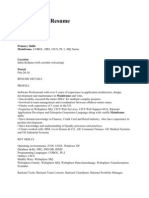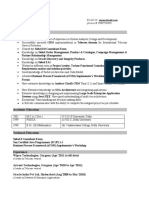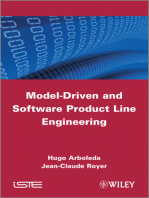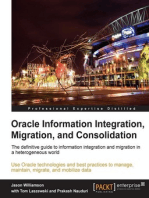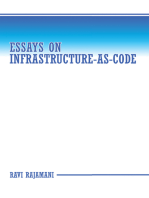0 ratings0% found this document useful (0 votes)
70 viewsCEMLI For Implementation Process
The document discusses different types of customization that can be done to an existing application: configuration, customization, extension, modification, localization, and integration. Configuration involves changing setup values to alter existing features. Customization includes altering standard objects or creating custom objects. Extension creates new custom code or enhances existing objects. Modification changes existing code. Localization defines support for different regions/languages. Integration connects data or applications through various interfaces. The document also mentions Oracle Unified Methodology which standardizes documentation for Oracle products.
Uploaded by
Vaibhav KulkarniCopyright
© © All Rights Reserved
Available Formats
Download as DOCX, PDF, TXT or read online on Scribd
0 ratings0% found this document useful (0 votes)
70 viewsCEMLI For Implementation Process
The document discusses different types of customization that can be done to an existing application: configuration, customization, extension, modification, localization, and integration. Configuration involves changing setup values to alter existing features. Customization includes altering standard objects or creating custom objects. Extension creates new custom code or enhances existing objects. Modification changes existing code. Localization defines support for different regions/languages. Integration connects data or applications through various interfaces. The document also mentions Oracle Unified Methodology which standardizes documentation for Oracle products.
Uploaded by
Vaibhav KulkarniCopyright
© © All Rights Reserved
Available Formats
Download as DOCX, PDF, TXT or read online on Scribd
You are on page 1/ 1
CEMLI: Configuration/Customization -Extension-Modification-Localization-Integration.
1) Configurations: Configurate the existing, Pre-build application feature according to client's
requirement. Changing setup and profile values can be examples of configuration.
2) Customization: Altering/Channing the standard objects or creation of custom object to meet
the clients business requirement at the time of implementation. It may be Extension and
Modification.
3) Extension: Extension means creating custom codes from scratch also Existing objects can be
used. It will be having different behavior from the seeded one.
4) Modification: Modification is enhancing/changing the existing codes to meet the client
requirement. It is the modification of seeded behavior.
5) Localization: it’s to define different legislative support provided by oracle applications based on
Country/Region/Language Requirements.
6) Integration: It can be Data Integration or Application Integration, options for these two are
Open Interface tables, APIs (Application Programming Interface), EAI (Enterprise Application
Integration Tools), EDI etc.
OUM (Oracle Unified Methodology :
Which is introduced by Oracle Corporation after 2007 to standardize the documentation. Process for
almost all products from oracle which includes Business Intelligence (BI) and Enterprise Performance
Management (EPM), Web Center, Service-Oriented Architecture (SOA), Application Integration
Architecture (AIA), Business Process Management (BPM), Enterprise Integration and Custom Software.
You might also like
- J2Ee Design Patterns: Intercepting FilterNo ratings yetJ2Ee Design Patterns: Intercepting Filter15 pages
- 01 - Functional - Setup - Manager - SpeakernotesNo ratings yet01 - Functional - Setup - Manager - Speakernotes20 pages
- 19111-Frequently Asked Questions in Oracle Application FrameworkNo ratings yet19111-Frequently Asked Questions in Oracle Application Framework7 pages
- Oracle BI Applications - Frequently Asked Questions (FAQ)No ratings yetOracle BI Applications - Frequently Asked Questions (FAQ)5 pages
- Suresh Nagavali Oracle EBS Technical ConsultantNo ratings yetSuresh Nagavali Oracle EBS Technical Consultant5 pages
- From Forms To HTML: Understanding and Using Oracle Projects' HTML PagesNo ratings yetFrom Forms To HTML: Understanding and Using Oracle Projects' HTML Pages6 pages
- EMC Documentum Foundation Services (Randall, SDC07)No ratings yetEMC Documentum Foundation Services (Randall, SDC07)34 pages
- Oracle OAF Interview Questions and AnswersNo ratings yetOracle OAF Interview Questions and Answers27 pages
- Business Rules Languages and Model-InteroperabilityNo ratings yetBusiness Rules Languages and Model-Interoperability4 pages
- Deloitte Uk Oracle Fusion Financials UnearthedNo ratings yetDeloitte Uk Oracle Fusion Financials Unearthed6 pages
- UtkarshChaturvedhi for AS400 Developer_Chennai_SagentNo ratings yetUtkarshChaturvedhi for AS400 Developer_Chennai_Sagent3 pages
- Rich User Experience (RUX) : Customizing Look and Feel (CLAF)No ratings yetRich User Experience (RUX) : Customizing Look and Feel (CLAF)10 pages
- A Distributed Component Architecture Model: ViewpointsNo ratings yetA Distributed Component Architecture Model: Viewpoints11 pages
- Oracle Information Integration, Migration, and ConsolidationFrom EverandOracle Information Integration, Migration, and ConsolidationNo ratings yet
- Applied Architecture Patterns on the Microsoft Platform Second EditionFrom EverandApplied Architecture Patterns on the Microsoft Platform Second EditionNo ratings yet
- Software Testing Interview Questions You'll Most Likely Be AskedFrom EverandSoftware Testing Interview Questions You'll Most Likely Be AskedNo ratings yet
- SQL Server Interview Questions You'll Most Likely Be AskedFrom EverandSQL Server Interview Questions You'll Most Likely Be AskedNo ratings yet
- Mastering Terraform A Comprehensive Guide to Infrastructure As CodeFrom EverandMastering Terraform A Comprehensive Guide to Infrastructure As CodeNo ratings yet
- PO Is Automatically Approved When The Approved Supplier List (ASL) Release Method Is Automatic PDFNo ratings yetPO Is Automatically Approved When The Approved Supplier List (ASL) Release Method Is Automatic PDF2 pages
- Complex Procurement in Oracle EBS R12: Bruce Kozlowski Director Solution ArchitectureNo ratings yetComplex Procurement in Oracle EBS R12: Bruce Kozlowski Director Solution Architecture30 pages
- Adding Responsibility To An Application User For Oracle ENo ratings yetAdding Responsibility To An Application User For Oracle E2 pages
- Government of Andhra Pradesh Model Form - RNo ratings yetGovernment of Andhra Pradesh Model Form - R2 pages
